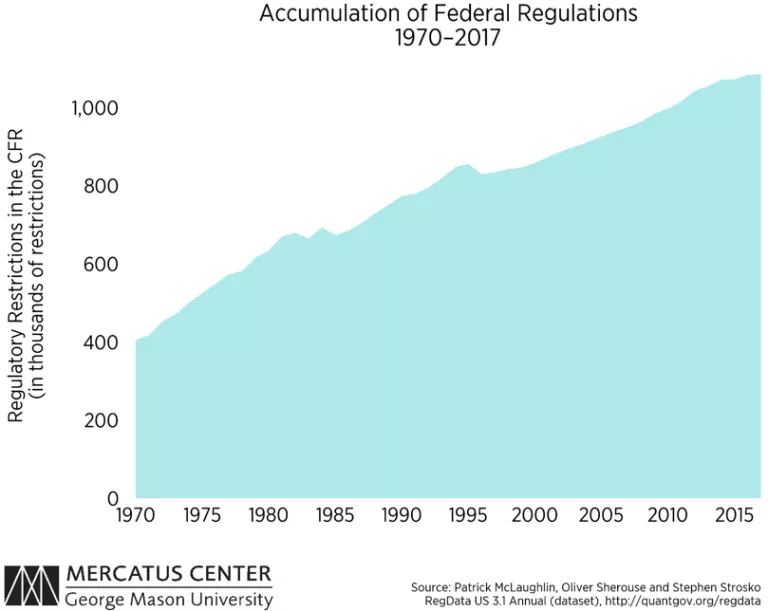- | Regulation Regulation
- | Expert Commentary Expert Commentary
- |
What Can the 1990s Tell Us about Good Regulatory Policy in the 21st Century?
Since Congress first delegated lawmaking authority to regulatory agencies more than a century ago, regulations have steadily grown. The number of regulatory restrictions in the Code of Federal Regulations (CFR), as quantified by RegData, has increased steadily since 1970 (the first year for which we have such data), resulting in 1,085,063 restrictions on the books presently.

However, a few deviations from the long-term growth trend are readily observable. In the early 1980s, a handful of Congressional acts led to the partial deregulation of some modes of transportation and the eventual dismantling of the Interstate Commerce Commission. The effects of these acts of Congress show up primarily in the first half of the 1980s.
The more interesting anomaly appears in the mid-1990s. Regulatory restrictions declined by 26,693 between 1995 and 1996, approximately a three percent decrease in total. The following three years saw growth rates of 0.69, 0.90, and 0.44 percent, all well below the average yearly growth in regulatory restrictions. It is very unlikely that regulators would choose to reduce the number of regulations for just one year—or that regulators would decrease regulatory growth dramatically the following three. Because of this anomaly, and the fact that this four-year period exhibited the slowest regulatory growth of any four-year period since 1970, we dove a little bit deeper into the history of the CFR and the political environment in the 1990s.
On March 3, 1993, President Bill Clinton created the National Performance Review (later named the National Partnership for Reinventing Government) and assigned his Vice President, Al Gore, to oversee the initiative. The goal of the 250 staffers employed by this initiative was to create a government that “works better, costs less, and gets results that Americans care about.” Gore hoped to achieve this goal by reducing administrative costs (budget, personnel, etc.) and eliminating wasteful regulations across government agencies.
The National Partnership for Reinventing Government had moderate success through its first few years of existence and this encouraged the Clinton administration to launch a “Phase II”. According to govinfo, Phase II included a major push in 1995 to identify unnecessary regulations in the CFR. Agencies responded accordingly and identified the equivalent of $28 billion in regulatory burden. A review written in March 1998 (according to the Initiative’s own estimate) claimed that the National Partnership for Reinventing Government led to the elimination of 16,000 pages in the CFR and the rewriting of an additional 31,000.
Interestingly, this tidbit of American political history largely flew under the radar. The reports from the National Partnership for Reinventing Government claimed that the initiative reduced regulatory growth. Indeed, the broad strokes of this claim were fairly easy to verify, for those who were interested. One merely need look at the total page count of the CFR, which declined by 7,126 pages (or 5.16 percent) between 1995 and 1997. Regulatory restrictions followed a similar decline from 1995 to 1996, further buttressing the claim that the National Partnership had reduced at least the quantity of regulations on the books. But ambiguity remains regarding how the reduced regulatory growth was achieved. RegData can be used to address the ambiguity by looking at which agencies helped drive this period of reduced regulatory growth.
The Occupational Safety and Health Administration (OSHA) was the biggest agency contributor to the National Performance Review’s initiative. From 1995 to 1999, OSHA’s regulatory text in the CFR declined by 11,025 regulatory restrictions.

Many of the deleted restrictions were in CFR title 29 parts 1910, 1915, and 1926 and are explained by a publication in the Federal Register called the “Consolidation of Repetitive Provisions; Technical Amendments,” published by OSHA on June 20th, 1996. Most of the restrictions removed by OSHA were duplicative restrictions added to the CFR in 1993 and 1994—also found in title 29, parts 1910, 1915, and 1926. However, this is not the case for all of the regulatory text that OSHA trimmed from the CFR in 1996.
Other major agency movers between 1995 and 1999 include the Agricultural Marketing Service, with a decrease of 9,477 regulatory restrictions, and the Federal Housing Administration, with a decrease of 5,046 regulatory restrictions. Overall, 19 agencies and departments reduced their regulatory restriction count by at least 1,000 during this time, including the Department of Energy, the Department of Veteran Affairs, and the Small Business Administration.
The reduction of red tape encouraged by the National Partnership for Reinventing Government did not establish a trend. Instead, the long run pattern of regulatory accumulation quickly re-established once the National Partnership initiative lost its steam. While the efforts of the mid-1990s to cut regulatory red tape should be applauded, any such short-lived regulatory reform efforts seem unlikely to meaningfully address the most problematic of regulations. Instead, the low-hanging fruit gets picked, a victory lap is taken, and it’s back to business as normal inside the beltway.
Photo credit: Doug Mills/AP/Shutterstock